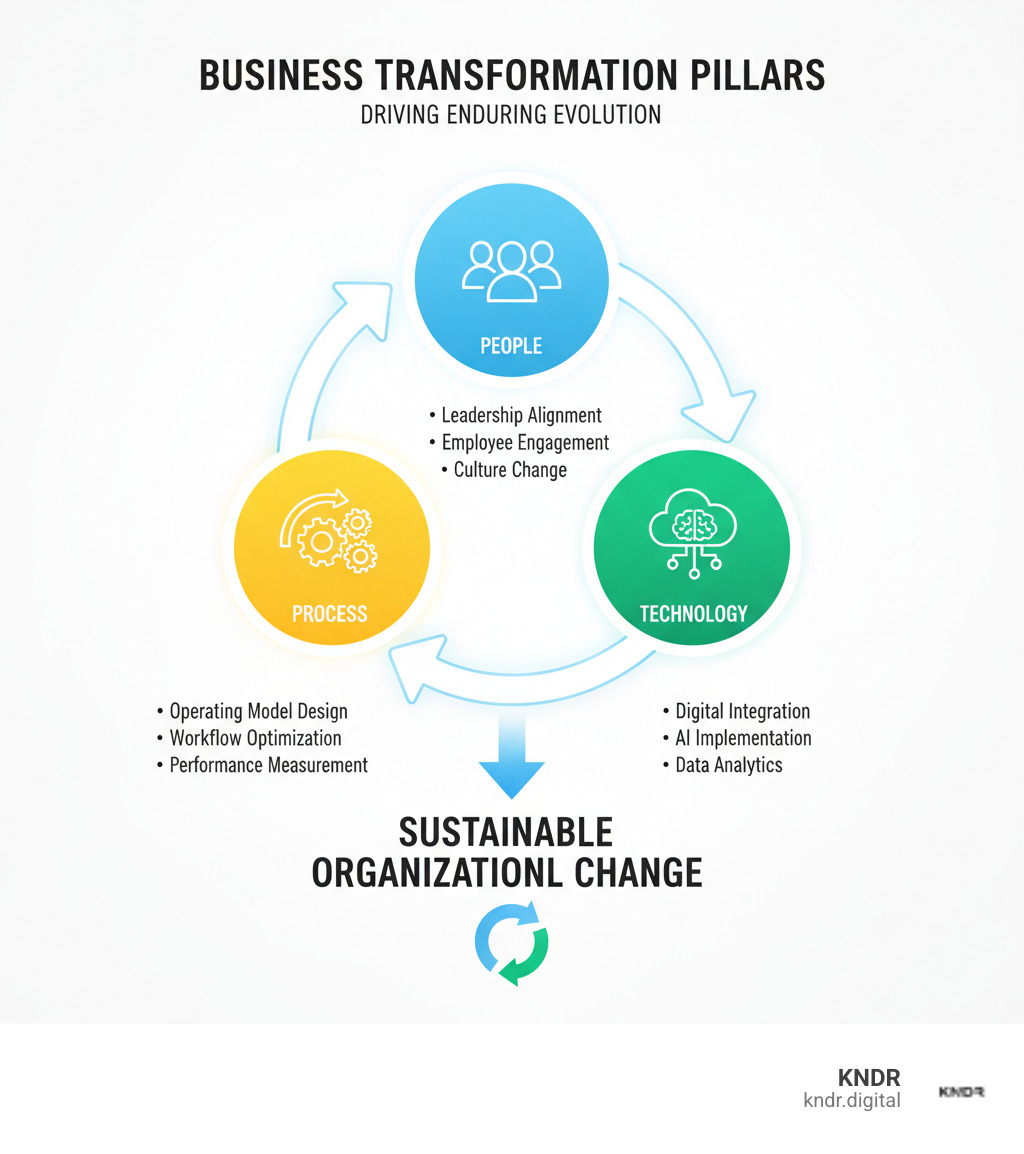From Chaos to Clarity: How Business Transformation Consultants Drive Success

Why Business Change Consultancy is Critical for Modern Organizations
Business change consultancy is a strategic service that helps organizations redesign their operations, technology, and culture to achieve sustainable growth. While many business changes fail, successful ones can deliver 15% higher total shareholder return and create lasting improvements.
Key Components of Business Change Consultancy:
- Strategic Planning: Aligning vision with execution.
- Operating Model Design: Restructuring processes, roles, and decision-making.
- Change Management: Ensuring people adopt new ways of working.
- Technology Integration: Leveraging digital tools and AI.
- Performance Tracking: Measuring impact through clear KPIs.
Business change creates fundamental shifts in how organizations operate and deliver value. Unlike digital change (focused on technology) or change management (focused on people), business change consultancy addresses the complete organizational ecosystem.
The stakes are high. Poor project performance wastes significant investment, while companies with excellent change management are far more likely to hit their objectives. High employee engagement during changes can also lead to significantly higher profitability.
As Mahir Iskender, CEO of KNDR.digital, I've helped mission-driven organizations steer complex changes using AI-powered strategies. My experience spans digital change, fundraising optimization, and organizational change management, applying these principles to the unique needs of the nonprofit sector.

Similar topics to business change consultancy:
Why Businesses Need Change: Drivers, Benefits, and Beating the Odds
Change is essential for survival. The question isn't if your organization needs to change, but how quickly you can adapt. Business change consultancy provides a strategic lifeline in this fast-moving environment.

Several forces drive this relentless need for change:
- Market disruption: New competitors and global events can reshape industries overnight.
- Competitive pressure: Rivals are constantly implementing new strategies to win your customers.
- Technological breakthroughs: AI and advanced analytics are creating new ways to operate.
- Shifting customer expectations: Customers demand more personalized, faster, and transparent service.
Proactive improvement drives sustainable growth, opens new revenue streams, and builds resilience. When done right, the rewards are significant. Organizations with high employee engagement during changes see 23% higher profitability. Streamlined processes and optimized resources also lead to dramatic improvements in operational efficiency and cost savings.
The High Cost of Inaction
Ignoring the need for change or executing it poorly is costly. Poor project performance leads to an average 11.4% investment loss, wasting capital on initiatives that don't deliver. This is often followed by a loss of market share to more agile competitors and decreased employee morale, which creates a cycle of cynicism and resistance to future initiatives. This is why we champion data-driven approaches in our work, including Data-Driven Fundraising, to ensure every investment yields measurable outcomes.
The Tangible Benefits of Success
Effective business change consultancy delivers remarkable results, characterized by three critical outcomes:
- Sustainable value creation: Generating long-term financial and strategic benefits, not just quick wins.
- Step-change in capabilities: Fundamental improvements in skills, processes, and technology.
- Sustained culture shift: Ensuring new behaviors and mindsets become part of the organization's DNA.
Companies achieving these outcomes are more likely to outperform their sector's average shareholder return. Furthermore, CX leaders often post stronger revenue growth than laggards, proving that customer-focused change delivers financial benefits. For nonprofits, this means higher impact and better Nonprofit Fundraising ROI. Organizations that accept strategic change don't just survive—they thrive.
The Blueprint for Success: A Guide to Business Change Consultancy
Starting a business change can feel like navigating without a map. Business change consultancy provides the guide and expertise to manage every turn. Success requires a holistic approach that addresses people, processes, technology, and culture simultaneously.

People-centric change is at the heart of our work. A new process or technology is useless if the team isn't on board. This means investing in engagement, upskilling, and communicating the "why" behind the change. When leaders are united and model desired behaviors, change becomes contagious. Key levers include cost reduction, digital integration, operating model redesign, and customer experience optimization.
The Core Methodology: From Vision to Value
Every successful change follows a proven path, customized to your starting point and goals.
- Assessment and diagnosis: We perform a health checkup of your organization to identify opportunities and define clear, measurable targets for success.
- Strategy formulation: We transform insights into a bold roadmap that articulates how your organization will win through change.
- Operating model design: We redesign how work gets done, from decision-making to team collaboration, ensuring your structure supports your strategy.
- Portfolio and roadmap development: Using a value, speed, and risk matrix, we prioritize initiatives into a rolling 90-day plan with clear owners and KPIs, like those in a Charity Campaign Strategy.
- Implementation and activation: We bring the plan to life through leadership routines, clear communication, and targeted training, launching adoption sprints focused on high-impact behaviors.
- Benefits tracking and sustainment: We create dashboards to track benefits and ensure changes stick, making continuous capability building part of your DNA.
The Role of AI in Modernizing Business Change Consultancy
AI is revolutionizing how we approach change itself. It helps us apply time-tested principles while navigating new questions about trust and scaling.

- AI for data analysis: Processes vast amounts of information to identify hidden patterns and opportunities.
- Predictive modeling: Forecasts market trends and customer behavior for more informed strategic decisions.
- Process automation: Handles repetitive tasks, freeing your team for more creative work.
- Personalized customer engagement: Delivers custom communications at scale, which is key for AI-Driven Fundraising and The Complete Guide to AI-Powered Donor Segmentation.
With most enterprises scaling Gen AI, strategic implementation is key to open uping productivity gains. This requires leaders who understand AI and can create safe spaces for experimentation.
Essential Expertise for an Effective Business Change Consultant
The best consultants are partners who combine multiple areas of expertise:
- Strategic thinking and financial acumen to align change with bottom-line impact.
- Change management skills to guide people through transitions.
- Data literacy to derive actionable insights from information.
- Industry knowledge to understand sector-specific dynamics.
- Communication skills and empathy to build trust and champion change.
At KNDR.digital, our consultants, like any effective Nonprofit Marketing Consultant, blend strategic insight with practical experience to deliver sound, actionable advice.
Measuring What Matters: Tracking Impact and Ensuring Sustainability
The truth about business change consultancy is simple: if you can't measure it, you can't manage it. And if you can't manage it, your efforts will likely join the 75% that fail to deliver lasting results. Effective changes create measurable impact across multiple dimensions, focusing on the numbers that truly matter to your bottom line and mission.
We track impact across four key areas:
- Financial impact: Increased revenue, reduced costs, and higher ROI.
- Operational efficiency: Improvements in cycle time, error rates, and resource utilization.
- Customer satisfaction: Measured through Net Promoter Score (NPS), churn rates, and engagement. CX leaders often see stronger revenue growth.
- Employee adoption and engagement: A critical factor, as teams with strong engagement deliver 23% higher profitability.
Key Performance Indicators for Change
Tracking change effectively requires balancing lagging indicators (results) with leading indicators (drivers). Leading indicators act as an early warning system—high user adoption today predicts stronger revenue tomorrow.
| Lagging Indicators (Results) | Leading Indicators (Drivers of Results) |
|---|---|
| Revenue Growth | User Adoption Rates |
| Profit Margin | Process Cycle Time Reduction |
| Customer Lifetime Value | Employee Training Completion Rates |
| Cost-to-Income Ratio | Leadership Alignment Scores |
| Net Promoter Score (NPS) | Communication Effectiveness |
| Customer Churn Rate | Project Milestone Achievement |
For nonprofits, these metrics are vital. A strong NPS can indicate donor satisfaction, while high engagement scores suggest a team committed to the mission. Our Nonprofit Fundraising Performance Metrics Guide explores these connections in detail.
How to Make Change Stick for Long-Term Success
Many organizations stumble after implementation, watching teams revert to old habits. Making change stick requires intentional, ongoing effort.
- Leadership modeling: When leaders visibly champion new approaches, they create psychological safety for others to follow.
- Manager coaching: Front-line managers must coach their teams to new KPIs and provide ongoing support.
- Continuous capability building: Ongoing investment in your team's skills ensures they can thrive in the new environment.
- Aligning incentives: Tying rewards to the behaviors that drive change reinforces new practices.
- Creating a culture of continuous improvement: Establishing mechanisms for feedback and learning makes your organization naturally agile.
The goal is to weave new systems so deeply into your organizational DNA that they become "how we do things here." Our approach to Implementing AI for Donor Retention: The Complete Playbook shows how new technologies must integrate with sustainable practices to deliver long-term value.
Navigating the Pitfalls: Why Changes Fail and How to Succeed
Let's be honest—change is hard. Despite compelling reasons to transform, many changes fail to meet expectations, with some studies showing failure rates as high as 70%.

These failures follow predictable patterns. Understanding them is the first step to avoiding them.
- Lack of clear vision: Without a compelling "why," people naturally resist leaving their comfort zone.
- Insufficient leadership support: If leaders aren't visibly and actively committed, the change will struggle.
- Poor communication: A vacuum of information gets filled with rumors, confusion, and fear, leading to resistance.
- Underestimating complexity: Change involves intricate webs of relationships and human psychology that are often overlooked.
- Failure to anchor new habits: Without consistent reinforcement, organizations naturally drift back to old ways.
Mitigation Strategies for Common Challenges
For every pitfall, there's a proven strategy. Business change consultancy professionals use systematic approaches to address each challenge.
- Establish a dedicated change office: This focused team coordinates moving pieces, allocates resources, and ensures accountability.
- Secure genuine executive sponsorship: True sponsors actively champion the change, communicate its importance, and remove obstacles.
- Implement robust change management: This is backed by hard data. Projects with excellent change management are up to 7x more likely to hit objectives. It involves systematically preparing, equipping, and supporting people through the transition.
- Foster open, two-way communication: Regular updates and honest discussions build trust and reduce fear.
- Celebrate early wins: Small victories build confidence and create momentum for the challenges ahead.
- Invest in people and culture: Recognizing that change is fundamentally about humans is critical, which is why our Nonprofit Donor Engagement Strategies focus on building lasting relationships.
By understanding these pitfalls and actively working to prevent them, organizations can dramatically improve their odds of success by managing risk intelligently.
Frequently Asked Questions about Business Change Consulting
When considering a business change consultancy, organizations often have similar questions. It's natural to have concerns about such a significant investment of time and resources. Here are the most common questions we hear.
What is the typical duration of a business change project?
The honest answer is: it depends on the scope and complexity. A project can range from a few months to several years. Streamlining a single department might take 3-6 months, while a full operating model redesign could be a multi-year journey.
Organizational size also plays a role. However, modern consultancies, including KNDR, focus on delivering value quickly. We use a phased approach with 90-day sprints, so you see tangible results every three months rather than waiting until the end. This builds momentum and allows for adaptation as we learn what works best for your situation.
How do you prioritize initiatives in a large-scale change?
Trying to do everything at once usually means nothing gets done well. We use a systematic approach to prioritization based on several factors:
- Value vs. Effort: We identify high-impact, low-effort initiatives to build early momentum.
- Risk Assessment: High-risk initiatives require more careful planning and may be phased differently.
- Dependencies: We map connections between initiatives to avoid bottlenecks and ensure a logical sequence.
- Capacity Planning: We remain realistic about what your team and systems can handle simultaneously.
- Strategic Alignment: Every initiative must directly contribute to your organization's primary goals.
This process results in a rolling 90-day plan with clear owners and KPIs, keeping everyone focused while allowing for flexibility.
How does business change consulting differ from change management?
This is a common point of confusion. While the terms sound similar, they represent different, complementary aspects of change.
Business change consulting is the big picture—the "what" and "why." It involves redefining strategy, redesigning how work gets done, optimizing processes, and integrating technology to achieve strategic goals. It addresses the entire organizational ecosystem.
Change management, on the other hand, focuses on the "how"—specifically, how people adapt. It's the people side of change, ensuring individuals and teams successfully adopt new processes and ways of working. It addresses resistance, builds skills, and fosters engagement.
In short, business change consulting encompasses change management as a critical component. You can't redesign an organization without helping its people steer the transition. At KNDR, when we implement AI-driven fundraising, we are doing business change consulting (redesigning strategy) while also focusing heavily on change management (ensuring staff and donors have a positive experience). The most successful changes integrate both from the start.
Conclusion: Changing Your Future with Clarity and Purpose
The business world has shifted. What were once optional improvements are now critical survival strategies. Business change consultancy serves as the bridge between where your organization is today and where it needs to be tomorrow.
Change is accelerating, driven by market disruption, technology, and shifting customer expectations. Standing still means falling behind. Organizations that execute change well see higher returns, develop new capabilities, and build adaptive cultures. Those that fail waste resources and lose ground to competitors.
Success lies in balancing three elements: strategic clarity, flawless execution, and engaged people. Technology, especially AI, is a game-changer, offering new insights and efficiencies. At KNDR.digital, we apply these principles to help mission-driven organizations amplify their impact, understanding their unique challenges of limited resources and diverse stakeholder needs.
Our approach combines rigorous change management with the heart of mission-driven work. We use data and AI to optimize fundraising, improve donor engagement, and create sustainable growth. Our results-based model—promising 800+ donations in 45 days or no payment—reflects our confidence in these proven methods.
The future belongs to organizations that can change effectively. Your mission, donors, and team deserve the best systems to succeed.
Let us help you transform your organization and turn your vision into measurable results.


